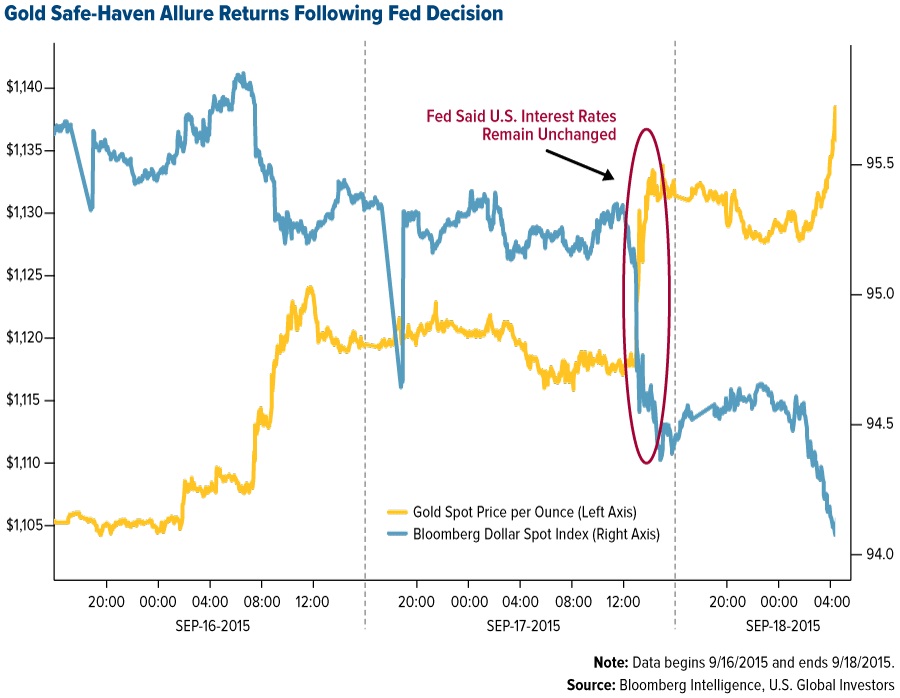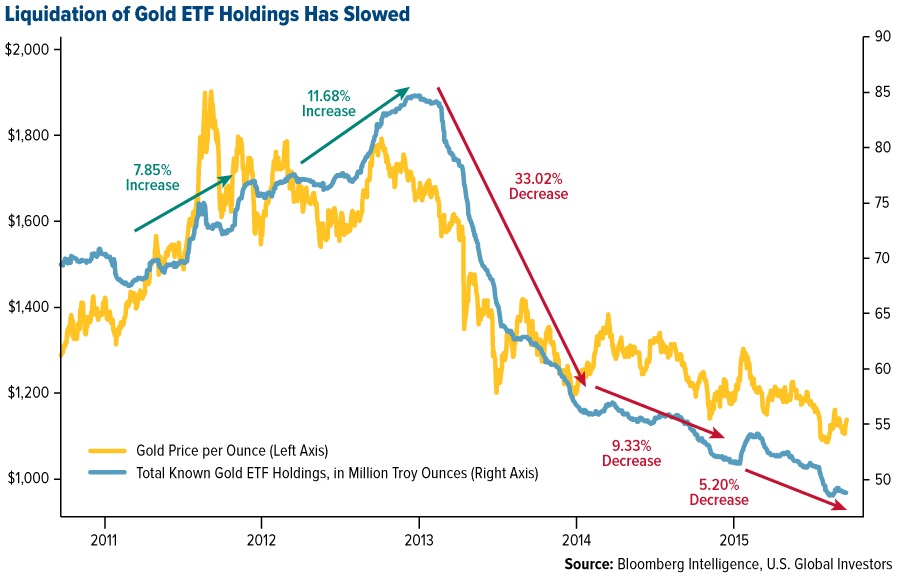Confidence In Gold As A Safe-Haven Asset Returns Following Fed Decision
Strengths
- Silver was the best performing precious metal last week, up 3.9 percent. It outperformed gold for the week on the back of increased offtake by industrial users and coin makers. Confidence in gold as a safe-haven asset returned following dollar weakness after the Federal Reserve left U.S. interest rates unchanged. The metal saw its first weekly gain in four weeks as a result. China’s economic slowdown, rising emerging-market currency volatility and the Fed highlighting “heightened uncertainties,” may persuade more investors to seek refuge in gold. This could be a bullish signal for gold, at least in the short-term, particularly as investors in China have been acquiring gold in anticipation of a rally.
- Roxgold provided a positive update on construction at its ultra-high grade Yaramoko project in Burkina Faso. The company announced that the Yaramoko water storage facility and tailings storage facility embankments were completed ahead of schedule, while the bulk earthworks at the mine camp are now 95 percent done. The underground mine is expected to produce 99,500 ounces per year for seven years, beginning mid-2016. Yaramoko is one of the highest grade, undeveloped deposits in the world, with an average grade of 11.83 grams per ton. It also contains some of the lowest costs in the industry, with all-in sustaining costs estimated at $590 an ounce. Sunridge Gold Corp. announced the signing of a mining agreement with the Eritrean Ministry of Energy and Mines. The ministry will issue three mining licenses, providing the key permits required for development of the four advanced projects – Emba Derho, Adi Nefas, Gupo Gold and Debarwa – that constitute Sunridge’s copper-zinc-gold project in Eritrea. Pretium Resources announced a $540 million construction financing package with the Orion Mine Finance Group and Blackstone Tactical Opportunities for its Brucejack Project. In doing so, Pretium largely funds a major, undeveloped gold project in Canada centered on a uniquely high-grade gold deposit.
- JPMorgan is calling a bottom on the mining sector, suggesting now is the time to pounce. The bank slapped an overweight on the sector this week, ending its bearish view. JPMorgan’s argument for miners was that in price-relative terms, mining is back to its levels from 10 years ago, when the Chinese commodity super-cycle was just starting. They see prices stabilizing in the coming year and note that miners have lowered capital spending in the past few years. They also believe that the bulk of EPS downgrades are behind us given the latest consensus projections of -44 percent year-on-year EPS growth for miners in 2015.
Weaknesses
- Platinum was the weakest precious metal for the week, rising 1.22 percent. Consumers in China purchased fewer autos in August, the third straight month of declines. This weighed on both platinum and palladium, which are used in gasoline engines to control emissions.
- According to a new Division of Minerals report put out by the state, just 4.94 million ounces were extracted from Nevada’s mines in 2014, compared to 5.5 million ounces in the previous year. 2014 was the first time since 1988 that production of the precious metals dropped so low. Various mines have been forced to close in recent years as they have not been able to stay profitable amid the plunge in the price of gold.
- Even stockpiles at a two-year low aren’t enough to cheer gold investors. Inventories of the metal on the Comex in New York have fallen for seven straight sessions to 6.89 million ounces, the smallest since October 2013. According to Jeffrey Christian, managing director at CPM Group, the Comex running low on stockpiles is a non-issue because most Comex futures contracts are cash settled and traders don’t take delivery of the metal. Additionally, while the percentage of Comex gold open interest covered by total Comex reported stocks has fallen over the past year and a half, it remains very high by historical standards. Furthermore, he added that gold futures, which have dropped more than 5 percent this year and are headed for a third straight annual decline, aren’t likely to rebound soon as the economic and political outlook probably won’t be threatening enough to generate a jump in investment demand until 2017. Nonetheless, the group said it considers bullion an excellent investment at current prices, on a long-term basis.
Opportunities
- According to Balvinder Kumar, of the Indian Mines Ministry, studies by state governments have uncovered some very deep and old mines with gold worth more than $3.9 billion existing in the Kolar region in the southern state of Karnataka alone. Allegedly, the ministry will put about 80 mines to auction within two or three months. That could allow miners to acquire rich assets at a time when valuations are low and sentiment toward the sector is still predominantly negative. Separately, Randgold Resources announced it has concluded a joint venture agreement to redevelop AngloGold Ashanti’s Obuasi gold mine in Ghana. Randgold said it would lead and fund the development plan to rebuild the mine, which is a large, high-grade deposit with proven and probable ore reserves of 24.53 metric tons at 6.70 grams per ton, making for 5.29 million ounces of gold.
- ETF gold holdings have declined by 5.2 percent this year, while gold has fallen by 6.3 percent. The pace of withdrawals has slowed, possibly indicating that sales may be coming to an end. Based on past rallies, ETF buying may pick up if gold prices start to climb. This could be prompted by the Chinese. The decline of the Chinese real estate market moved billions of dollars into the country’s stock market, which saw a dramatic rise and then equally sharp decline. If Chinese investors fleeing from stocks decide that the historic value in gold is tempting, that could mean the next boom could come in gold. The metal has historically been a safe-haven in countries that suffer from bouts of inflation as well as political upheaval.
- China continues to be one of the world’s largest buyers of gold as gold deliveries from the Shanghai Gold Exchange continue to set record highs. SGE volumes were up 14.2 percent through August versus the same month in 2014, and are on pace to reach almost 2,600 metric tons of gold this year. The planned establishment of a yuan-based gold fix by the SGE by the end of 2015 also shows that China wants to have its say in the global pricing of the metal.
Threats
- Researchers say they found scattered accumulations of heavy metals along 60 miles of riverbank in Colorado and New Mexico after the Gold King Mine spill. About 3 million gallons of wastewater rushed out of the mine August 5 after a cleanup crew supervised by the Environmental Protection Agency inadvertently breached a debris dam. Congressional investigators are looking into why the EPA didn't do more to find out how much toxic water was inside Gold King before using heavy machinery to open it. The agency needs to answer that question publicly and tighten its procedures accordingly. Unlike the oil and gas sector, companies that extract gold, silver, uranium and other heavy metals from federal lands pay no royalties to the government. Legislation in the House of Representatives threatens this by the potential of amending the 1872 law that still governs mining. The intention would be to force the mining industry to help foot the bill for disasters like this.
- An Argentine court has ordered a five-day suspension of the gold leaching process at Barrick Gold Corp's Veladero mine to determine whether there was any environmental damage from a cyanide leak triggered by a faulty valve. A lengthier prolongation of the mine closure could have materially adverse economic impacts on the company.
- Palladium-backed ETFs in August had their biggest monthly outflow in six months as prices slid to a five-year low of $533 an ounce. Demand for the metal, mainly used in emission control systems of gasoline-fueled vehicles, has been hurt by a three-month decline in Chinese auto sales. Given stock market volatility and worsening economic data out of China, this rout could have more room on the downside as consumers feel the pinch.
Courtesy of http://www.usfunds.com/









 Frank Holmes is the CEO and Chief Investment Officer of
Frank Holmes is the CEO and Chief Investment Officer of 










